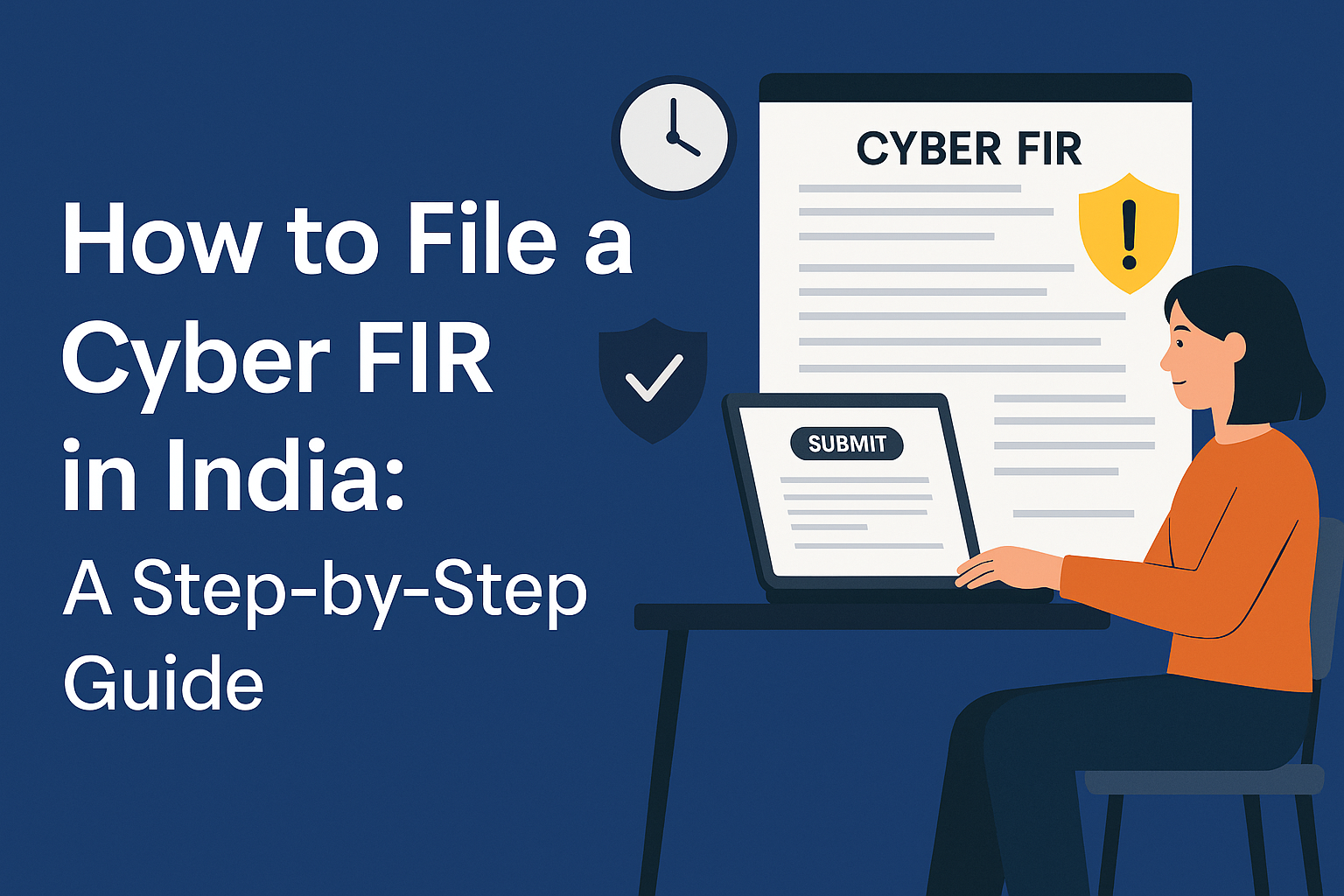In today’s digital landscape, cybercrime has emerged as a significant threat affecting individuals and businesses alike. From financial fraud and identity theft to cyberbullying and online harassment, these crimes can cause substantial damage. The Indian government has established mechanisms to address these issues through the cybercrime reporting system. This comprehensive guide will walk you through the process of filing a Cyber FIR (First Information Report) in India, ensuring you know exactly what steps to take when faced with a cybercrime.
Understanding Cyber FIR
A Cyber FIR is an official complaint registered with law enforcement authorities regarding crimes committed in the digital space. It serves as the first step in the legal process against cybercrimes and initiates the investigation by relevant authorities.
Common Cybercrimes in India
- Financial Fraud: Online banking fraud, credit card scams, UPI fraud
- Identity Theft: Unauthorized use of personal information
- Phishing Attacks: Fraudulent attempts to obtain sensitive information
- Social Media Crimes: Harassment, defamation, fake profiles
- Data Breaches: Unauthorized access to databases containing personal information
- Ransomware Attacks: Malicious software that locks access to files until a ransom is paid
- Cyberstalking: Online harassment or unwanted attention
- Online Sexual Harassment: Inappropriate content, revenge porn, sextortion
Before Filing a Cyber FIR: Essential Preparations
1. Document Everything
Before approaching authorities, gather all relevant evidence:
- Take screenshots of all relevant communications and websites
- Save copies of emails, messages, and social media posts
- Record dates and times of suspicious activities
- Maintain a chronological log of events
- Preserve financial records if money was involved (transaction details, payment screenshots)
2. Act Quickly
Time is crucial in cybercrime cases. Evidence can be altered or deleted, and digital footprints may fade over time. Report incidents as soon as you identify them.
Filing a Cyber FIR: Step-by-Step Process
Option 1: Online Reporting Through the National Cybercrime Reporting Portal
The most convenient way to report a cybercrime is through the official government portal.
Step 1: Access the Portal
- Visit www.cybercrime.gov.in
- The portal is available in multiple Indian languages
Step 2: Choose Reporting Type
- Report Anonymously: For providing information without revealing your identity
- Report as a Victim/Complainant: For filing a formal complaint (recommended)
Step 3: Select Crime Category
- Choose the appropriate category for your complaint:
- Financial Crime
- Social Media Crime (harassment/bullying)
- Online Content related to Child Sexual Abuse
- Other Cybercrimes
Step 4: Fill the Complaint Form
- Provide personal details (name, contact information, address)
- Enter crime details (platform, date and time, description)
- Be specific and concise in your description
Step 5: Upload Evidence
- Attach relevant screenshots, emails, transaction details
- Ensure files are in acceptable formats (PDF, JPEG, PNG) and within size limits
Step 6: Submit and Track
- Submit the completed form
- Note down the complaint reference number
- Use this number to track the status of your complaint
Option 2: Reporting via Helpline
For immediate assistance, especially in financial fraud cases:
- Dial 1930: National Cybercrime Helpline
- Provide details of the incident
- Follow instructions given by the helpline operator
Option 3: In-Person Reporting at Police Station or Cybercrime Cell
Step 1: Locate the Appropriate Police Station
- Visit your nearest police station or dedicated cybercrime cell
- Major cities have specialized cybercrime police stations
Step 2: Meet with the Officer
- Request to meet the officer in charge of cybercrime cases
- Explain your situation clearly and calmly
Step 3: File a Written Complaint
- Submit a written complaint with all relevant details
- Include personal information, incident details, and evidence
- Ensure you receive an acknowledgment of your complaint
Step 4: Follow Up for FIR Registration
- Request the registration of a formal FIR
- Obtain a copy of the FIR for your records
- Note down the FIR number for future reference
After Filing the Complaint: What to Expect
Investigation Process
- Initial Assessment: Authorities review your complaint to determine jurisdiction and severity
- Case Assignment: Your case is assigned to an investigating officer
- Evidence Collection: Technical evidence is gathered from service providers, banks, etc.
- Suspect Identification: Authorities work to identify perpetrators
- Legal Proceedings: If sufficient evidence is found, legal action is initiated
Your Responsibilities
- Remain Available: Be accessible for further questioning or clarifications
- Provide Additional Information: If you remember new details or discover more evidence
- Follow Up Regularly: Check the status of your complaint periodically
- Be Patient: Cybercrime investigations can be complex and time-consuming
Special Considerations for Different Types of Cybercrimes
Financial Fraud
- Contact your bank immediately to freeze accounts or block cards
- Report to the banking ombudsman if necessary
- Preserve all transaction details and communications with fraudsters
Social Media Harassment
- Report the content to the platform before filing a police complaint
- Block the harasser to prevent further communication
- Document all instances of harassment with dates and times
Data Breach
- Change passwords for all affected accounts
- Enable two-factor authentication where possible
- Monitor your accounts for suspicious activities
Legal Framework for Cybercrimes in India
Understanding the legal provisions can help you file a more effective complaint:
- Information Technology Act, 2000 (as amended in 2008): The primary legislation dealing with cybercrimes
- Indian Penal Code: Many traditional offenses have been adapted to cover digital crimes
- Key Sections:
- Section 66: Computer-related offenses
- Section 66C: Identity theft
- Section 66D: Cheating by personation
- Section 66E: Privacy violation
- Section 67: Publishing obscene material
- Section 67A: Publishing sexually explicit content
- Section 67B: Child pornography
Important Contact Information
- National Cybercrime Reporting Portal: www.cybercrime.gov.in
- National Cybercrime Helpline: 1930
- Emergency Police Services: 112
- Women Helpline: 181
Tips for Preventing Cybercrimes
Digital Hygiene Practices
- Use Strong Passwords: Create unique, complex passwords for different accounts
- Enable Two-Factor Authentication: Add an extra layer of security
- Update Software Regularly: Install security patches promptly
- Be Cautious with Public Wi-Fi: Avoid financial transactions on public networks
- Verify Before Clicking: Don’t click suspicious links or download unknown attachments
- Review Privacy Settings: Regularly check and update privacy settings on social media
- Monitor Your Accounts: Check bank statements and credit reports regularly
Conclusion
Filing a Cyber FIR is a crucial step in seeking justice for digital crimes. While the process might seem daunting, the systems in place are designed to assist victims and bring perpetrators to justice. By acting promptly, preserving evidence, and following the proper reporting channels, you contribute to making the digital space safer for everyone.
Remember that cybercrime is a serious offense under Indian law, and authorities are increasingly equipped to handle these cases. Your diligence in reporting not only helps your specific case but also strengthens the overall fight against cybercrime in India.
Disclaimer: This article is for informational purposes only and does not constitute legal advice. For specific legal guidance, please consult with a qualified legal professional.


